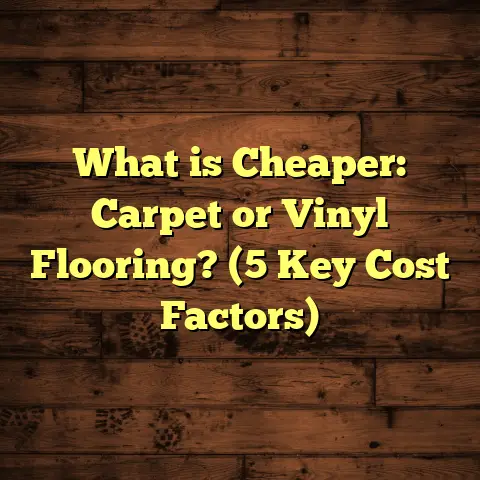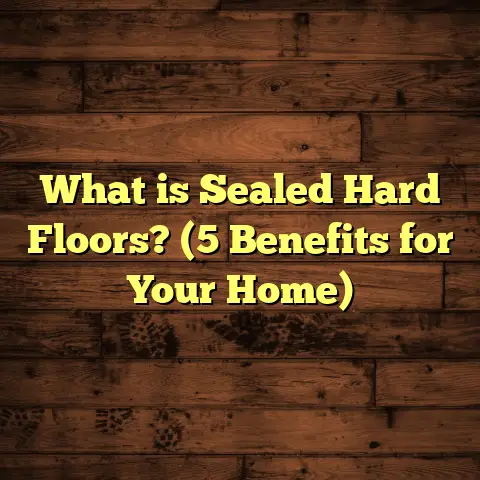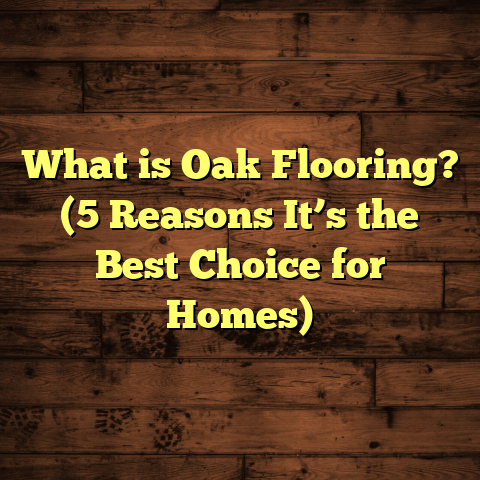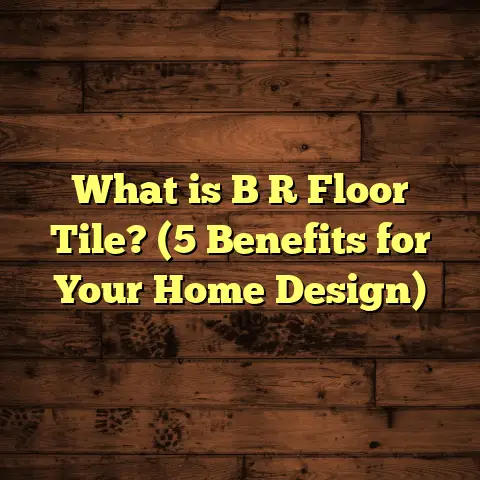What is Floor Type? (5 Essential Styles for Your Home)
What is Floor Type?
You might have heard people say,
“Flooring is just flooring,” like it’s all the same
thing. But that’s not true at all. Over the years,
I’ve learned that choosing the right floor type can
change the whole vibe and function of your home. So,
what exactly is a floor type? Simply put, floor type
refers to the kind of material and style used to cover
your floor surface. It’s the base that holds your
furniture, the stage for your daily life, and sometimes
even a design statement.
The floor type you pick affects durability, comfort,
maintenance, and, of course, the look of your space.
It’s more than just a covering—it’s part of your lifestyle.
I’ve worked in many homes and seen firsthand how
picking the wrong floor can lead to headaches, and how
the right one can bring joy for years.
Before I jump in, I want to bust a common myth: many
people think that flooring is just about aesthetics. That
if it looks good, it’s good enough. But from my hands-on
experience, I know there’s way more to it. Your floor has
to fit your lifestyle, withstand wear and tear, and be easy
to maintain. Otherwise, you’re setting yourself up for
frustration.
Understanding Floor Types: What Are They Really?
When we say “floor type,” we are talking about the kind
of material used to cover your subfloor—the surface under
your feet. Floor types can vary widely in composition,
appearance, durability, and cost.
The most common floor types include hardwood, laminate,
vinyl, tile, and carpet. Each of these has its own unique
characteristics and best-use scenarios.
To help you understand better, I’ll break down each in detail,
sharing what I’ve learned over thousands of square feet of
installations and repairs.
1. Hardwood Flooring: The Timeless Classic
When I first started in flooring, hardwood was everywhere.
There’s something about natural wood—the grain patterns,
the warmth—that just never goes out of style. Hardwood is
made from solid planks of wood like oak, maple, or cherry.
Why Hardwood?
Hardwood floors are often chosen for their natural beauty
and long lifespan. They can be sanded and refinished multiple
times over decades, which means they’re highly durable if cared for properly.
I helped a client install white oak hardwood in her dining
room a few years ago. She wanted something warm but not dark,
and the floor absolutely transformed the space. Guests would
often compliment the natural glow and feel underfoot.
Successes with Hardwood
- Value: Homes with hardwood floors tend to sell faster and for higher prices. According to a 2023 real estate report, homes with hardwood floors sold for an average of 2-3% more than those without.
- Aesthetics: Hardwood offers unmatched beauty with unique grain patterns and color variations.
- Longevity: With proper care, hardwood floors can last 50 years or more.
Challenges I’ve Seen
- Water Sensitivity: One installation taught me a hard lesson about moisture. A client wanted hardwood in their kitchen without considering spills or humidity. Within a year, some boards warped due to water exposure. Hardwood is not the best choice for wet areas unless you use special finishes or engineered options.
- Cost: Hardwood is expensive upfront. Material costs alone range from $6 to $12 per square foot; installation adds another $3-$8 per square foot depending on complexity.
- Scratches & Dents: Hardwood can scratch easily from pets’ nails or furniture movement. One client with an energetic dog had to refinish her floor sooner than expected.
Pro Tips from My Hardwood Projects
- Always ask about the room’s moisture levels before choosing hardwood.
- Consider engineered hardwood if you want wood look but need more moisture resistance.
- Use area rugs in high-traffic zones to prevent wear.
- Invest in quality finishes or sealants to add protection.
2. Laminate Flooring: Affordable Style with Practicality
Laminate flooring is essentially a composite wood product topped with a photographic image layer that simulates wood or stone. It’s one of my favorites when clients need style on a budget.
Why Laminate?
I installed laminate flooring in my sister’s basement because it was affordable and durable enough for a high-use area that occasionally gets damp. The click-together installation was straightforward and saved us a lot of time.
Successes with Laminate
- Cost-effective: Laminate materials cost between $2 and $6 per square foot — significantly cheaper than hardwood.
- Scratch Resistance: It resists scratches better than natural wood thanks to its tough wear layer.
- Ease of Installation: Many laminate floors are floating floors that snap together without glue or nails.
Challenges from My Experience
- Water Damage: Laminate doesn’t handle moisture well; standing water will cause swelling and damage. In one renovation, we had to rip out laminate after a plumbing leak because it buckled badly.
- No Refinishing: Once damaged, laminate planks must be replaced entirely; you can’t sand them down like hardwood.
- Less Authentic Look: While new laminates have greatly improved visuals, some people still prefer the feel and authenticity of real wood.
Data Points on Laminate
A study by the National Floor Covering Association found that laminate flooring sales rose by 4% annually over five years due to its affordability and performance in homes with children and pets.
3. Vinyl Flooring: Practicality Meets Style
Vinyl used to be considered cheap and ugly — but not anymore. Today’s luxury vinyl planks (LVP) are waterproof, durable, and can closely mimic wood or tile.
My Vinyl Flooring Story
I recommended vinyl flooring for a young family with two toddlers who needed something that could handle spills and mud tracked inside. The result was impressive—easy cleanup and no visible wear after several months of heavy use.
Advantages I’ve Noted
- Waterproof: Vinyl is perfect for bathrooms, kitchens, basements—anywhere moisture is a concern.
- Durability: It resists dents better than other softer surfaces.
- Comfort: It’s softer underfoot than tile or hardwood and warmer on cold days.
Challenges I’ve Encountered
- Indentation Risk: Heavy furniture can dent vinyl flooring if not properly supported with pads.
- Appearance: Cheaper vinyl still looks plastic-y; only higher-end products mimic natural materials well.
- Environmental Concerns: Vinyl is made from PVC plastics which raises questions about sustainability for eco-conscious homeowners.
Industry Trends
Vinyl flooring has grown in popularity by 8% annually over recent years according to market research firms due to its affordability combined with performance upgrades.
4. Tile Flooring: Beauty That Lasts
Tile is known for its strength and water resistance. I enjoy installing ceramic or porcelain tile because it offers endless design possibilities—from classic subway tiles to bold mosaics.
Why Tile?
One client wanted a bathroom makeover with a splash of personality; we used patterned porcelain tile that added character while standing up to daily use.
Strengths I’ve Seen
- Longevity: Tile floors can last over 100 years if maintained properly.
- Water Resistance: Ideal for wet areas like bathrooms or kitchens.
- Design Variety: Comes in countless colors, shapes, sizes — you can customize endlessly.
Downsides From Experience
- Cold & Hard: Some clients say tile feels uncomfortable on bare feet—especially in bedrooms or living rooms.
- Installation Costs: Tile installation requires skillful labor which drives costs up—$7-$15 per square foot including labor is common.
- Subfloor Preparation: Uneven or improperly prepared subfloors cause cracking or loose tiles; I’ve spent days fixing issues caused by poor prep work in older homes.
5. Carpet Flooring: Comfort Underfoot
Carpet offers softness and warmth that no hard surface can match. I often recommend it for bedrooms or playrooms where comfort is key.
Why Choose Carpet?
I helped a family with young children pick carpet for their living room because it cushioned falls and muffled noise—a big plus when kids run around constantly!
Benefits I’ve Seen
- Sound Absorption: Carpet reduces noise dramatically compared to hard surfaces.
- Comfort: Softness underfoot makes standing or sitting for long periods easier on joints.
- Variety: Available in countless textures, colors, and patterns to suit any décor.
What I’ve Learned About Carpet Challenges
- Allergens: Carpet traps dust mites and allergens which can worsen breathing problems—something clients with allergies should consider carefully.
- Stains: Spills stain easily; regular professional cleaning can be costly over time.
- Durability: Wears out faster than hard surfaces in high traffic areas; expect replacement every 8–12 years depending on usage.
Real-Life Case Studies From My Flooring Projects
Sometimes stories tell it best. Here are two detailed examples from my work that highlight successes and challenges with floor types:
Case Study 1: Hardwood Pitfalls in Humid Climate
A couple wanted solid hardwood installed throughout their coastal home. They loved the look but didn’t realize their area’s high humidity would cause wood expansion and cupping after heavy rains. Within months, we had multiple boards lifting at edges.
We ended up replacing most of the floor with engineered hardwood designed to handle moisture better—a costly fix but necessary for long-term satisfaction. This taught me never to overlook climate factors when recommending floor types.
Case Study 2: Vinyl Victory in High-Traffic Rental
I renovated a rental property often rented by families and students who left floors dirty or wet from shoes and spills. Installing luxury vinyl plank flooring meant tenants could mop up messes easily without damage or staining.
After two years the floors looked nearly new despite heavy use—saving the landlord thousands in repair costs compared to carpet or hardwood alternatives.
How I Manage Flooring Costs Efficiently
Budgeting can get complicated quickly with so many variables involved: materials, labor rates, waste percentages, subfloor repairs—you name it! Early in my career, I struggled estimating accurate costs which sometimes led to overruns or undervaluing jobs.
Now I use an online tool called FloorTally regularly. It lets me input room dimensions along with material choices and local labor costs so I can get detailed estimates fast. What’s handy is how it accounts for waste factor automatically—I don’t have to guess how much extra material I’ll need for cuts or mistakes.
Having realistic numbers upfront helps me plan projects better and set clear expectations with clients—avoiding surprises later on that could cause frustration or budget blowouts.
What About Maintenance? A Look at Longevity Across Floor Types
Another big part of choosing floors is thinking about upkeep:
| Floor Type | Maintenance Frequency | Typical Lifespan | Common Issues |
|---|---|---|---|
| Hardwood | Weekly sweeping; annual refinishing | 30+ years (up to 50+) | Scratches; moisture damage |
| Laminate | Weekly sweeping; avoid water | 10–20 years | Water damage; scratches |
| Vinyl | Weekly sweeping; mop as needed | 15–25 years | Indentations; fading |
| Tile | Regular cleaning; grout sealing every few years | 50+ years | Cracked tiles; grout stains |
| Carpet | Vacuum weekly; professional cleaning yearly | 8–12 years | Stains; allergen buildup |
Final Thoughts From My Experience
Choosing the right floor type comes down to balancing style preferences with practical needs: budget, durability, maintenance ease, climate conditions, lifestyle factors like kids or pets, and even resale value if you plan to sell down the line.
From my experience:
- Hardwood offers unmatched beauty but needs care.
- Laminate blends affordability with decent durability.
- Vinyl is great for wet areas or busy homes.
- Tile brings elegance but requires more upfront investment.
- Carpet delivers comfort but demands upkeep.
Every home and family situation is unique—so take your time exploring options before making decisions. If you want recommendations tailored specifically to your space or budget constraints, just ask!
If you’re curious about how tools like FloorTally might help you estimate your next flooring project or want me to walk you through some sample calculations based on your rooms—I’m happy to help out anytime!





